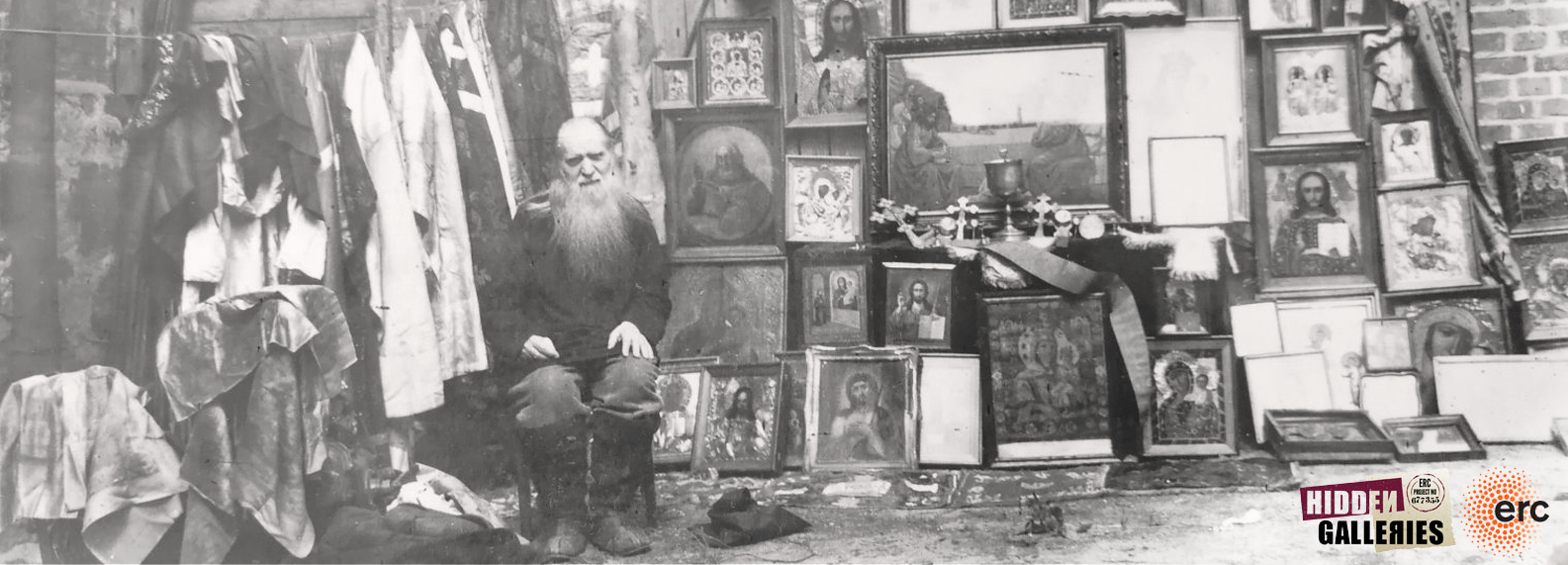Secret police photographs of Ioannite community Ukraine
Item
Title
Secret police photographs of Ioannite community Ukraine
Фотографії з кримінальної справи проти Іоанітів, Україна
Фотографии из криминального дела против Иоаннитов, Украина
Description
The photographs come from a 1959 KGB criminal case against three members of an Ioannite community in Cherkasy region, Ukraine. The images were designed as a photo album pasted into the secret police file. They portray father Mitrofan, the priest of the community in his house, which had been turned into a clandestine chapel. The first photo collage shows father Mitrofan dressed in Orthodox vestments against a background of icons, performing a religious service and talking to women, seemingly his followers. The second photo collage records the ritual washing of feet, also performed in father Mitrofan’s home. These photographs differ from typical secret police arrest or surveillance images. They intend to depict religious community life in an apparently natural context. At the same time the good quality of the photos, taken with a bright artificial light, indicate that these representation of rituals were staged.
The last three images show the results of a police search of the clandestine chapel. The photos of cash confiscated during the police search and a table nicely served with food and drinks were used as incriminating evidence of the priest’s profiting from illegal economic activities. An image of a coffin and shelves with religious literature were intended to demonstrate the esoteric and fanatically sectarian nature of a repressed community. The last image constitutes a valuable source for the study of folk icons and handmade religious images circulated in the Soviet-era religious underground. It depicts confiscated and later destroyed icons used by the community. Apart from the portrait of father Mitrofan himself, there is an image of father John (Ioann) of Kronstadt, a famous Russian priest venerated by the community as a saint (hence the name of believers, the Ioannites). There is also a picture of Ambrose of Optina, placed together with the portrait of father John of Kronstadt in the same frame. Hieroschemamonk Ambrose was one of the most famous starets in Optina Monastery. He is pictured here on his deathbed. The choice of that image appears to be meaningful, as death and the afterlife were particularly sensitive issues for the community. The believers even built a clandestine Christian cemetery called “New Jerusalem”, photographs of which are also present in the secret police file as incriminating evidence.
Ioannitism was a popular apocalyptic and chiliastic movement that emerged from the Russian Orthodox tradition at the beginning of the 20th century. The Ioannites were mainly peasant believers from the Russian and Ukrainian countryside, who venerated father John of Kronstadt (1829-1909), an archpriest from a town near St. Petersburg, one of the most popular religious personalities in late imperial Russia. A charismatic preacher, he was known as a blessed healer and wonder-worker, “the first modern Russian religious celebrity, with his image in souvenir scarves, mugs, placards, and postcard” (Kizenko 2000:2). During his lifetime, the pilgrimage to Kronstadt became a mass phenomenon, as thousands of believers all over Russia travelled to Kronstadt to see the “prophet.” Ioannitism, however, never constituted a unified religious movement, neither theologically, nor organisationally. It was rather constituted of dispersed peasant communities and individual wondering book-sellers, prophets and prophetess united by the common apocalyptic vision of the world, and centred around the figure of father John. Some believers remained within the Russian Orthodox Church, venerating father John as a blessed worshiper; others worshiped father John as the prophet Elijah or the embodiment of the Trinity, or Jesus Christ himself, thus, cutting themselves off from the official Church structures.
In the early Soviet period, the Ioannites were persecuted as harmful ecclesiastic-monarchist sectarians. Driven underground, Ioannite communities built clandestine chapels and continued to live as underground monastic communities scattered from Western Siberia to Ukraine. Repression and shared underground experience drew the Ioannites together with catacomb True Orthodox communities. In the later years, this was even further facilitated by the Soviet secret services that made no distinction between the Ioannites and the True Orthodox Christians. Thus, the arrested believers in this criminal case were charged as the members of the True Orthodox Church.
Father Mitrofan was known among believers as a miraculous healer. The village of Osytniazhka, where he lived, attracted numerous pilgrims who sought his blessing and spiritual help. The trial of father Mitrofan and his followers in 1959 was widely publicised. Apart from the official trial, a show-like civil trial was also held, which was recorded and later turned into a propaganda film titled “The End of a Spider.” The verbatim record of the civil trial is attached to the secret police file. Some photos found in the secret police file also appear in the film, which proves that the film was made under the direct supervision of the secret services.
The photographs in this entry come from the State Archive Branch of the Security Services of Ukraine in Kyiv. The file reference is: fond 6, sprava 75174. The file consists of three volumes. Along with the photographs presented in this entry there are other images of the community and their religious artefacts. The file contains also numerous interrogation records of arrestees and witnesses. Three original Ioannite handwritten manuscripts of “The Dream of Father John of Kronstadt” are also attached to the file. Other confiscated religious writings, such as “The Explanation of the Apocalypse”, the brochure “Life story of starets father Mitrofan”, and Mitrofan’s homilies were destroyed as they are absent in the file. Their images, however, appear in the above mentioned propaganda film.
For further readings see:
Kizenko, Nadieszda. A Prodigal Saint: Father John of Kronstadt and the Russian People. Pennsylvania State University Press, 2003
Tepliakov, A.G. Ioannity Zapadnoi Sibiri v dokumentakh VChK-OGPU-NKVD (1920-1940 gody). Vestnik Tverskogo gosudarstvennogo universiteta. Seria: Istoria, 2010, vol. 30(4):128-136
Shugaeva, L. Ioannity: Techiia khiliastychno-eskhitalohychnoho spriamuvannia pravoslavnoho pokhodzhennia. Ukrainske relihieznavstvo. 2006, vol. 39:145-153
For related entries see:
The last three images show the results of a police search of the clandestine chapel. The photos of cash confiscated during the police search and a table nicely served with food and drinks were used as incriminating evidence of the priest’s profiting from illegal economic activities. An image of a coffin and shelves with religious literature were intended to demonstrate the esoteric and fanatically sectarian nature of a repressed community. The last image constitutes a valuable source for the study of folk icons and handmade religious images circulated in the Soviet-era religious underground. It depicts confiscated and later destroyed icons used by the community. Apart from the portrait of father Mitrofan himself, there is an image of father John (Ioann) of Kronstadt, a famous Russian priest venerated by the community as a saint (hence the name of believers, the Ioannites). There is also a picture of Ambrose of Optina, placed together with the portrait of father John of Kronstadt in the same frame. Hieroschemamonk Ambrose was one of the most famous starets in Optina Monastery. He is pictured here on his deathbed. The choice of that image appears to be meaningful, as death and the afterlife were particularly sensitive issues for the community. The believers even built a clandestine Christian cemetery called “New Jerusalem”, photographs of which are also present in the secret police file as incriminating evidence.
Ioannitism was a popular apocalyptic and chiliastic movement that emerged from the Russian Orthodox tradition at the beginning of the 20th century. The Ioannites were mainly peasant believers from the Russian and Ukrainian countryside, who venerated father John of Kronstadt (1829-1909), an archpriest from a town near St. Petersburg, one of the most popular religious personalities in late imperial Russia. A charismatic preacher, he was known as a blessed healer and wonder-worker, “the first modern Russian religious celebrity, with his image in souvenir scarves, mugs, placards, and postcard” (Kizenko 2000:2). During his lifetime, the pilgrimage to Kronstadt became a mass phenomenon, as thousands of believers all over Russia travelled to Kronstadt to see the “prophet.” Ioannitism, however, never constituted a unified religious movement, neither theologically, nor organisationally. It was rather constituted of dispersed peasant communities and individual wondering book-sellers, prophets and prophetess united by the common apocalyptic vision of the world, and centred around the figure of father John. Some believers remained within the Russian Orthodox Church, venerating father John as a blessed worshiper; others worshiped father John as the prophet Elijah or the embodiment of the Trinity, or Jesus Christ himself, thus, cutting themselves off from the official Church structures.
In the early Soviet period, the Ioannites were persecuted as harmful ecclesiastic-monarchist sectarians. Driven underground, Ioannite communities built clandestine chapels and continued to live as underground monastic communities scattered from Western Siberia to Ukraine. Repression and shared underground experience drew the Ioannites together with catacomb True Orthodox communities. In the later years, this was even further facilitated by the Soviet secret services that made no distinction between the Ioannites and the True Orthodox Christians. Thus, the arrested believers in this criminal case were charged as the members of the True Orthodox Church.
Father Mitrofan was known among believers as a miraculous healer. The village of Osytniazhka, where he lived, attracted numerous pilgrims who sought his blessing and spiritual help. The trial of father Mitrofan and his followers in 1959 was widely publicised. Apart from the official trial, a show-like civil trial was also held, which was recorded and later turned into a propaganda film titled “The End of a Spider.” The verbatim record of the civil trial is attached to the secret police file. Some photos found in the secret police file also appear in the film, which proves that the film was made under the direct supervision of the secret services.
The photographs in this entry come from the State Archive Branch of the Security Services of Ukraine in Kyiv. The file reference is: fond 6, sprava 75174. The file consists of three volumes. Along with the photographs presented in this entry there are other images of the community and their religious artefacts. The file contains also numerous interrogation records of arrestees and witnesses. Three original Ioannite handwritten manuscripts of “The Dream of Father John of Kronstadt” are also attached to the file. Other confiscated religious writings, such as “The Explanation of the Apocalypse”, the brochure “Life story of starets father Mitrofan”, and Mitrofan’s homilies were destroyed as they are absent in the file. Their images, however, appear in the above mentioned propaganda film.
For further readings see:
Kizenko, Nadieszda. A Prodigal Saint: Father John of Kronstadt and the Russian People. Pennsylvania State University Press, 2003
Tepliakov, A.G. Ioannity Zapadnoi Sibiri v dokumentakh VChK-OGPU-NKVD (1920-1940 gody). Vestnik Tverskogo gosudarstvennogo universiteta. Seria: Istoria, 2010, vol. 30(4):128-136
Shugaeva, L. Ioannity: Techiia khiliastychno-eskhitalohychnoho spriamuvannia pravoslavnoho pokhodzhennia. Ukrainske relihieznavstvo. 2006, vol. 39:145-153
For related entries see:
Цi фотографії є частиною кримінальної справи КДБ 1959 р. проти трьох членів громади іоаннітів у Черкаському регіоні України. На фото – отець Митрофан, священник підпільної православної громади, у своєму будинку, перетвореному на домашню церкву. Перший фото колаж зображує отця Митрофана, одягненого у православну рясу на фоні ікон, він проводить релігійну службу і спілкується з жінками, як вважається, його послідовницями. На другому фото колажі – ритуальне омивання ніг, також у будинку отця Митрофана. Ці фотографії відрізняються від тих, що зазвичай робить таємна поліція при арештах і спостереженнях. Вони намагаються змалювати життя релігійної громади у достатньо натуральному контексті. У той же час, висока якість фотографій, зроблених при яскравому штучному освітленні, вказують, що це – постановка ритуалів.
На останніх трьох фото результати обшуків підпільного храму. Фото грошей і стола, сервірованого їжею і напоями, були використані як докази вини священника у використанні незаконної діяльності з метою отримання вигоди. Фото труни і поличок з релігійною літературою намагались показати ізотеричну і фанатично-сектантську природу репресованої громади. Останнє фото є важливим джерелом досліджень народного релігійного мистецтва та іконотворчості. Воно зображує конфісковані і пізніше знищені ікони, що циркулювали у релігійному підпіллі радянської ери. Окрім портрета самого отця Митрофана, там також є образ отця Іоанна Кронштадтського, відомого російського священника, якого громада вважала святим (звідси і назва віруючих - іоанніти). Також є зображення Амброзія Оптинського, розміщене поряд із портретом Іоанна Кронштадтського, у тій же рамці. Ієромонах Амбросій був одним з найбільш відомих старців у Оптинському монастирі. Він зображений на смертному ложі. Вибір цього зображення невипадковий, адже смерть і життя після смерті мали особливо важливе значення для громади. Віруючі навіть побудували підпільне християнське кладовище, яке назвали “Новим Єрусалимом”. Фотографії кладовища також знаходяться у справі як доказ вини.
Іоаннітство було популярною апокаліптичною і хіліастичною релігійною течією, що виникла на основі Російської православної традиції на початку 20 століття. Іоанніти були здебільшого селянами з російських і українських сіл, що вважали отця Іоанна Кронштадтського (1829-1909рр.), протоієрея з невеликого міста біля Санкт Петербургу, святим. Він був однією з найбільш популярних особистостей у пізньоімперіалістичній Росії. Харизматичний священик був відомий як обдарований цілитель і чудотворець, “перша сучасна російська знаменитість, що зображувалася на сувенірних шарфах, кружках, плакатах і листівках” (Кіценко 2000:2). Під час його життя, паломництво у Кронштадт стало масовим, оскільки тисячі віруючих з усієї Росії подорожували до Кронштадта, щоб побачити “пророка”. Іоаннітство, тим не менш, ніколи не було уніфікованим релігійним рухом, ні з теологічної, ні організаційної точки зору. Скоріше це були розрізнені сільські громади і окремі продавці книжок, об’єднані спільним апокаліптичним баченням світу і центровані навколо фігури отця Іоанна. Деякі віруючі залишались у рамках Російської православної церкви, виславляючи отця Іоанна як благословенного священика; інші вважали отця Іоанна пророком Іллею, чи втіленням Святої Трійці, чи самим Ісусом. На початку радянського періоду іоаннітів переслідували як шкідливих церковно-монархістських сектантів. Загнані у підпілля, іоанніти будували домашні храми і продовжували жити підпільними громадами, розкиданими від західної Сибірі до України. Репресії і схоже підпільне життя зблизило іоаннітів з катакомбними Істинно-православними громадами. Пізніше радянські секретні служби вже не визначали різниці між іоаннітами і істинно-православними. Таким чином, заарештовані у даній справі отримали звинувачення як члени Істинно-православної церкви.
Віруючі знали отця Митрофана як чудотворця і цілителя. Численні пілігрими приходили до села Оситняжка, де він проживав, у пошуках благословення і духовної допомоги. Суд над отцем Митрофаном і його послідовниками, що відбувся у 1959 р., здобув розголосу. Окрім офіційного суду відбувся показовий громадянський суд, який був записаний у форматі відео і згодом вийшов у вигляді фільму під назвою “Кінець павука”. Дослівна стенограма громадянського суду міститься у кримінальної справі. Деякі фото, що знаходились у справі таємної поліції, також показані у фільмі, що доводить, що фільм був випущений під прямим наглядом секретних служб.
Дані фотографії знаходяться у Галузевому державному архівi Служби безпеки України, фонд 6, справа 75174. Справа складається з трьох томів. Окрім даних фотографій справа містить фото громади і їх релігійних артефактів. Окрім того, записи численних допитів заарештованих і свідків, три оригінальні рукописи іоаннітів “Мрія Отця Іоанна Кронштадтського”. Інші конфісковані релігійні записи, такі як “Пояснення Апокаліпсису”, брошура “Життя старця отця Митрофана” і проповіді Митрофана були знищені, оскільки відсутні у справі. Але вони з’являються у кадрах вищезгаданого пропагандистського фільму.
Subject
Communism and Christianity--Europe, Eastern
Communism and religion
Communism--Europe, Eastern--History--20th century
Secret police (secret service)
Surveillance
Material culture--Religious aspects
Religion and politics--Europe
Religious sects
Christian sects--Soviet Union
Communism and culture--Soviet Union
Confiscations
Evidence photographs
Evidence, criminal
Folk icons
Monastic and religious life of women
Soviet Union. Ministerstvo gosudarstvennoĭ bezopasnosti
Vernacular architecture
Creator
Tatiana Vagramenko
Source
Галузевий державний архів Служби безпеки України
ГДА СБУ ф. 6, спр. 75174
https://ssu.gov.ua/
ГДА СБУ ф. 6, спр. 75174
https://ssu.gov.ua/
Publisher
This project has received funding from the European Research Council (ERC) under the European Union’s Horizon 2020 research and innovation programme No . 677355
The research for this entry was funded by Irish Research Council, GOIPD/2017/764
The research for this entry was funded by Irish Research Council, GOIPD/2017/764
Date
1959
Rights
Copyright for these images belongs to the State Archive Branch of the Security Services of Ukraine
https://ssu.gov.ua/
https://ssu.gov.ua/
Format
Image/jpg
Photo
Photo
Language
RU
Type
Image
Identifier
SBU Archive, f. 6, spr. 75174
https://ssu.gov.ua/
https://ssu.gov.ua/
Coverage
Ukraine
Soviet Union
20th Century
Soviet Union
20th Century
Bibliographic Citation
Tatiana Vagramenko, "Secret police photographs of Ioannite community Ukraine"
Date Created
2018
Item sets
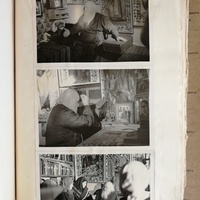 Surveillance photos of father Mitrofan and his community
Surveillance photos of father Mitrofan and his community 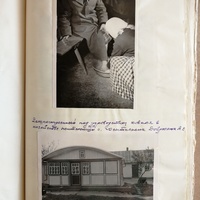 Ritual washing of feet
Ritual washing of feet 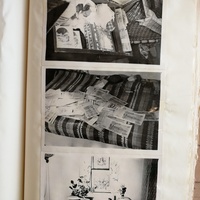 Confiscated cash and a table full of food as incriminating evidence
Confiscated cash and a table full of food as incriminating evidence 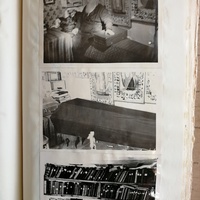 Suitcase, coffin and a library in a clandestine chapel
Suitcase, coffin and a library in a clandestine chapel 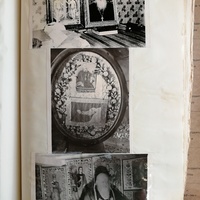 Confiscated folk icons
Confiscated folk icons 